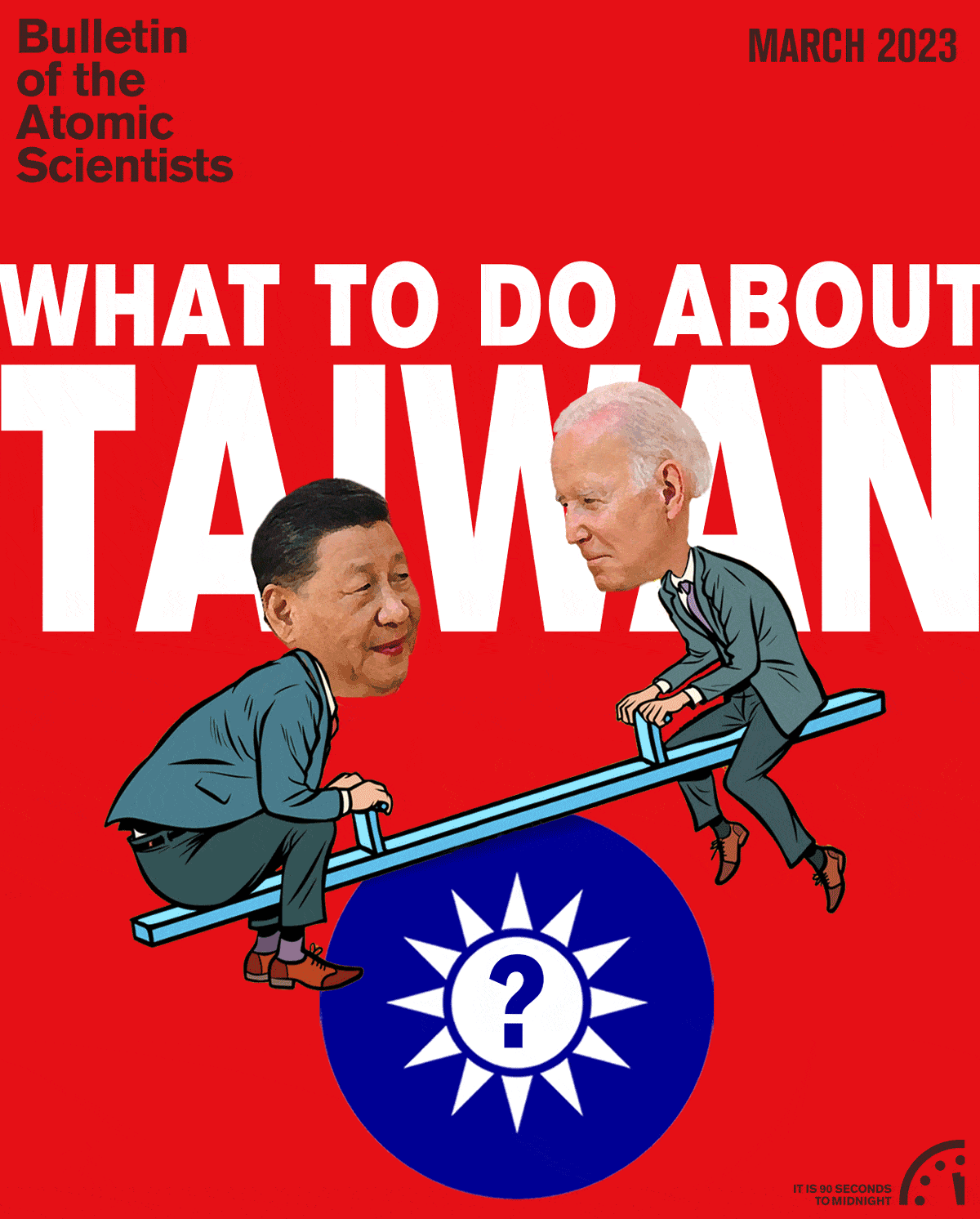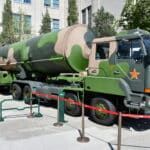Deterring a Chinese military attack on Taiwan
By Larry Diamond, James O. Ellis, Jr. | March 13, 2023
Deterring a Chinese military attack on Taiwan
By Larry Diamond, James O. Ellis, Jr. | March 13, 2023
The brutal Russian invasion of Ukraine has given the world a tragic reminder of both the pitiless destructiveness of war as well as the existential and unpredictable danger posed by powerful authoritarian states—particularly those dominated by megalomaniacal strongman leaders. Today the focus is on Ukraine’s heroic struggle to defend and recover its territory and its democratic way of life. But at some time in the coming years, the arena of conflict over the future of democracy could shift to the Indo-Pacific, if the People’s Republic of China (PRC) does what its communist leaders have long threatened to do: use force to compel Taiwan (which it has always regarded as a “renegade” province) to “reunify with the motherland.”
For decades following the Chinese Communist Party’s (CCP) conquest of the mainland in 1949, this was a contingency that US military planners regarded as a dangerous but manageable threat. Despite occasional outbursts of military bluster, as with the threats and missile launches off Taiwan’s coast that the PRC issued in advance of Taiwan’s March 1996 presidential election, China lacked the military capacity to launch a successful amphibious invasion of Taiwan. The 1996 threat met a powerful rebuff from the United States when President Bill Clinton sent two US aircraft carrier battlegroups to international waters near Taiwan, and then one of them through the Taiwan Strait. Taiwan’s election went off without a hitch, returning to the presidency the candidate Beijing had wanted to defeat, Lee Teng-hui, in the first democratic election for that office.
But Beijing resolved then to build up the military strength to succeed in imposing its will at some later date, and to avoid being humiliated again by the US Navy.
After decades of following Deng Xiao-ping’s famous dictum, “Hide your strength, bide your time,” the PRC under President Xi Jin-ping is done “hiding and biding.” Having received his coveted third term as China’s paramount leader at the CCP’s 20th Party Congress last October, Xi is now bent on achieving his grand strategic aims to achieve “national rejuvenation” and to end the “century of humiliation” that occurred from 1839 to 1949, when China lost control of significant territory to foreigners. Taiwan is now the principal remaining territory that the PRC insists must be recovered (Kaufman 2011). But under Xi Jin-ping, the larger goal is to, in essence, make China great again by becoming, at a minimum, the dominant power in Asia. For China to be dominant, the United States. must be effectively pushed out of the region, and annexing Taiwan (whether through military and geopolitical pressure or outright war) is a critical step toward that goal.
China does not need to act militarily now. For one thing, Taiwan will have another presidential election in January 2024. After eight years in the opposition, the Kuomintang (KMT)—the long-ruling party in Taiwan after its defeat in the Chinese Civil War in 1949, and still one of the two principal political parties in Taiwan today—could return to the presidency in that 2024 election, at the helm of a government that Beijing would believe to be more trustworthy and open to negotiation. For decades, the key PRC goal has been to prevent Taiwan from pursuing independence (that is, permanent separation) rather than to compel unification by a certain date. Even if its goal has shifted to the latter, Beijing would no doubt prefer to wait to use force at least until its current campaign of military modernization is complete. The new (accelerated) deadline for that is 2027, marking the 100th anniversary of the founding of China’s People’s Liberation Army, or PLA. In testimony before the Senate Armed Services Committee in March 2021, Admiral Phil Davidson, then the commander of the US Indo-Pacific Command, warned that the threat of Chinese military action against Taiwan could be “manifest” within six years—i.e., by 2027. Davidson worried that the growing military imbalance could embolden China to act decisively “before our forces may be able to deliver an effective response” and added, “I cannot for the life of me understand some of the capabilities that they’re putting in the field, unless … it is an aggressive posture.”
Though the precise timeline or even likelihood of Chinese action is the subject of continuing analysis and speculation, their capability and capacity for action continues to grow dramatically. Whether it is 2027 or by the end of this decade, China will have a formidably powerful and modernized military, with a much more professional and tech-savvy officer corps, “more naval ships than the US,” and a “larger, more survivable” and more potent and precise nuclear arsenal than it now has, with hypersonic weapons that the US does not have.
Another weapon that China is rapidly developing, and which the United States does not have, is an anti-ship ballistic missile that can hit and kill aircraft carriers quickly from a distance of 800 nautical miles (about 1,482 kilometers), and eventually much further. And this is not to mention the yawning and ever-widening gap between PRC and Taiwan military capabilities, with China possessing armed forces not only roughly 10 times as large in personnel, but with staggering advantages in surface vessels and tanks (an 8 to 1 advantage). Even if one looks only at the forces assigned to the Eastern and Southern theater navies, China has 21 destroyers to Taiwan’s four, 41 frigates to Taiwan’s 22, and 37 submarines to Taiwan’s two, plus 700 fighter planes and 250 bombers stationed near Taiwan (to Taiwan’s 400 fighters and no bombers). China now has alarming qualitative advantages in some of these areas as well. Moreover, these numbers reflect the strength of the PLA in 2020; the imbalance is even more dramatic today. And in terms of readiness, China’s massive numerical advantages give it the ability to wear out Taiwan’s planes and pilots as they continually scramble in response to the PLA’s escalating intrusions into Taiwan’s Air Defense Identification Zone.
Could China be defeated in an all-out attempt to take Taiwan by force? The cautious and sobering answer of a new study by the Center for Strategic and International Studies (CSIS) is “yes,” but at a staggering cost. After running 24 wargames with different scenarios last year, the CSIS study concluded that Taiwan, the United States and Japan, acting closely together, could defeat a Chinese amphibious invasion, but at the cost of “dozens of ships, hundreds of aircraft, and thousands of servicemembers,” and the devastation of Taiwan’s economy. A heavy share of the losses would be sustained by the United States, so damaging its global military and geopolitical leadership that it could be a “pyrrhic victory,” giving China a chance to recover and win in the future (Cancian, Cancian, and Heginbotham 2023).
And victory would require the active military engagement of the US armed forces and ideally Japanese Self-Defense Forces, as well as the dedicated resistance and preparation of the Taiwan armed forces. The bottom line of the CSIS study matches our own: The United States, Taiwan, and Japan must do much more to prepare to defeat a Chinese military attack on Taiwan. Increasing military strength, deployment, readiness, and internal and external military interoperability will not only help to ensure that China loses if it makes the colossal historical mistake of attacking, but it will also increasingly deter China from attacking in the first place.
Why Taiwan matters
The Russian invasion of Ukraine has been the biggest shock to the post-World War II order since its creation three-quarters of a century ago. A major power has sought to invade and extinguish the sovereignty of a neighboring state, and furthermore, a democratic one. Not even the Soviet invasion of Afghanistan, grave as it was, matched that level of brazen disregard for international norms.
In the case of Taiwan, it is true that only a small minority (13) of the 193 member states of the UN have formal diplomatic relations with Taiwan (also known as the Republic of China). The number has steadily shrunk under PRC diplomatic pressure, which insists that Taiwan is not a state and has sought to isolate it from participation in international organizations, even forums that do not require statehood to participate. But even much more so than Ukraine, Taiwan is a very successful “third wave” democracy; indeed, it is one of the most liberal, “high-quality” democracies in Asia and by some international assessments, rates as more democratic than the United States.
There is a strong moral case for helping Taiwan to defend itself. A Chinese military conquest (or coerced surrender) of Taiwan would not bring anything like the promised “one country, two systems,” which was never fully honored in Hong Kong but has been completely eviscerated in the last few years. Taiwan would be directly ruled by Beijing as the 23rd province of the PRC, with its extraordinary democratic pluralism crushed and its most prominent and outspoken democrats thrown in prison. If one of the most liberal and vibrant democracies in the world could simply be wiped off the face of the map by a neo-totalitarian superpower aggressor, what would this imply for the future of freedom in Asia?
The psychological consequences of a PRC military conquest of Taiwan would cast a dark shadow over the entire Indo-Pacific region. American credibility in the region would be in shreds. The states of the region would see that the United States lacked either the will or the ability to prevent China from forcing its will on the 23 million people of Taiwan, which is not only one of the most vibrant democracies but also one of the most dynamic economies of the region. Even the democracies and semi-democracies of the region, which are wary of China’s hegemonic intentions (as are some authoritarian regimes, like Vietnam) would see the need to “accommodate” to China’s demands in the South China Sea and beyond.
Strategically, it would be the beginning of the end of America’s ability to secure freedom and prevent authoritarian hegemony in East Asia. China would turn the island of Taiwan into a giant military platform to project power northward, (perhaps eventually absorbing Japan’s Senkaku islands), southward (pressuring the Philippines and consolidating its total control of the South China Sea) and to the southeast (asserting geopolitical and military dominance over the Pacific Island states). At that point, China would control the sea lanes through which up to a third of global trade passes, and no state or combination of states in the region would be strong enough to defy Beijing’s demands in the region.
And then there are the well-documented stakes for the global trade in semiconductors. About 50 percent of the world’s semiconductors and 90 percent of the most advanced chips are produced in Taiwan. Should Beijing gain de facto control over semiconductor production in Taiwan, it would gain potentially devastating leverage over the US, European and Japanese economies. Should Taiwan’s semiconductor fabs—manufacturing plants in which raw wafers of silicon are made into integrated circuits—be decimated or rendered inoperable by a Chinese military invasion, the damage to the world economy would be so severe that some observers believe that alone could trigger a global depression.
American policy makers and the larger public must weigh this question: Is the defense of Taiwan’s democracy a vital interest of the United States. We believe it is. And if it is, we must do much more to prepare now to decisively defeat—and thereby to deter—any act of PRC aggression against Taiwan.
Deterring, and if necessary, winning a military conflict over Taiwan
There is no consensus on whether or when China will use force to “reunify” Taiwan with the mainland. But most experts agree that the risk is rising dramatically and that the time horizon has now shrunk from decades to years. We have no time to lose. We must embark on a comprehensive strategy of deterrence through strength and preparedness because some of the steps will take years to accomplish. Taiwan and the United States, and our key allies Japan and ideally Australia, must project a clear resolve to fight and a readiness to win. This will require rapid enhancements in force composition and posture. To wit:
What Taiwan must do
A crucial element of deterrence is for Taiwan to convince the PRC that it will mount a fierce, determined, and creative resistance (in the spirit of Ukraine) that will enable it to hold out until support arrives from the United States and its allies.
Over the past two decades, the military balance across the Taiwan Strait has shifted dramatically in favor of the PRC as Taiwan’s military spending steadily fell to only 1.7 percent of GDP. Until recently, Taiwan has been massively underprepared for what it may face. But it has been jolted out of its slumber by several recent developments: the steadily rising pace of Chinese military capabilities, intimidation, and intrusions into Taiwan’s Air Defense Identification Zone; the PRC’s suppression of the pro-democracy movement in Hong Kong and termination of “one country, two systems;” the war in Ukraine; and the massive PLA military exercises after Speaker Nancy Pelosi’s visit to Taiwan.
Many more Taiwanese now realize the urgency of the situation. Recently, Taiwan’s government has begun moving in the necessary direction by announcing an increase in mandatory military service from four months (widely derided as “summer camp”) to one year. Taiwan is also increasing its military budget in a steady rise since 2018 from 1.7 percent to well over 2 percent of its GDP. The proposed defense budget for fiscal year 2023 will raise defense spending nearly 14 percent to over $18 billion in US dollars, representing 2.4 percent of its GDP, with heavy increased investments in personnel (including reserve brigades), logistics, fuel, and maintenance, to improve readiness and the ability to respond to the growing pace of PLA intrusions into Taiwan’s waters and air space. The budget will also support purchases of new F-16 fighter jets to respond to the PLA air intrusions, and Harpoon long-range anti-ship missiles.
These are very positive developments. But Taiwan has little margin for error, and the more it spends on expensive legacy systems—like Abrams tanks and advanced fighter jets, which could be largely destroyed in the early hours of a Chinese attack—the less will be available for what could make the greatest difference: a system of “distributed, survivable, and affordable defenses” that could “make Taiwan a harder target against invasion” (Timbie and Ellis, 2021).
This “porcupine strategy” of emphasis on asymmetric warfare builds on the Overall Defense Concept introduced by Adm. (ret) Lee Hsi-minh, who served as chief of staff of Taiwan’s armed forces from 2017 to 2019. What Taiwan most needs now, to quote James Timbie and James Ellis, are “large quantities of small, mobile, affordable and resilient anti-air and anti-ship systems that could survive initial strikes and effectively resist airborne or amphibious invasion.” The more quickly and energetically that Taiwan builds this kind of swarming, distributed, stealthy, fast, and easily maintainable arsenal, the more cost-effective will be the increases in Taiwan’s military acquisitions, the more rapidly they can be deployed, and the better the odds that Taiwan can deter an invasion—by making what is already one of the most difficult operations in warfare (an amphibious invasion) too costly and risky to contemplate.
Taiwan must therefore shift more of its defense spending to the purchase of many small, lethal, mobile weapons systems, particularly Harpoon missiles, Stinger portable air defense missiles, ships to lay advanced mines, and missile corvettes. Former head of the Defense Innovation Unit Michael A. Brown has also suggested the purchase of smart mines (that can be turned on and off), and two other weapons systems that have made a big difference to Ukraine’s defense against Russia’s invasion—Javelin anti-tank missiles and the High Mobility Artillery Rocket System (HIMARS) (Brown 2022 and 2023).
But it is not enough for Taiwan to purchase these weapons; we must deliver them in a timely fashion before a conflict begins. The Ukraine conflict has exposed critical vulnerabilities in current US capacity to surge production of these weapons. As Brown stresses, we need to ramp up the US’ ability to supply these weapons systems and increase the capacity of component vendors, perhaps by invoking the Defense Production Act to command US industry to expedite production on an emergency basis. But this may also suggest the wisdom of immediately licensing production of some of these weapons (for example, Stingers) to Taiwan’s highly capable defense industry.
Taiwan must also do much more to prepare not only for a possible invasion, with crushing impacts on infrastructure and critical supplies, but also a potential PRC blockade that would attempt to strangle Taiwan into submission. Consequently, Taiwan needs to accelerate dramatically the amassing of stockpiles of weapons, energy, and other critical resources.
Taiwan’s energy supplies are particularly vulnerable to disruption. Taiwan produces only 12 percent of its own energy. Much of its electricity supply runs on natural gas, and importers are only required to maintain a stockpile of eight days. In addition to being caught in the LNG pricing challenges of the increasingly fungible global gas markets, Taiwan’s nascent efforts to expand solar power and offshore wind are lagging near-term goals, beset by infrastructural and geographic challenges. However, there are some other rays of hope on the energy front.
Another critical safety net for keeping the lights on in a Taiwan emergency could be nuclear power, which now provides 11 percent of Taiwan’s electricity, and more cheaply than by other means. That’s not much, but in a crisis, it could be enough to continue critical functions until a Chinese blockade could be broken or an invasion defeated. It is very unlikely that China would attack Taiwan’s nuclear power plants directly, as that would be seen as equivalent to using nuclear weapons in the conflict—and even Russia backed away from that option in Ukraine.
The problem is that the ruling Democratic Progressive Party has already mothballed two new advanced plants under construction and has pledged to shut down Taiwan’s three operational nuclear power plants by 2025. Hopefully, whichever party wins the presidency in 2024 will recognize that with a growing threat of PRC military aggression, Taiwan simply cannot afford to give up its one source of independent and reliable energy. Finally, learning real-time lessons from the Ukrainian conflict, Taiwan has begun a major effort to modernize the island’s aging electricity distribution system in order to create a more robust and resilient power grid.
What the United States must do
The United States faces a delicate set of challenges in preparing for a Taiwan contingency. If it were to formally abandon “strategic ambiguity” for an unambiguous declaration that the United States will go to war against China to defend Taiwan, this (in itself) could be seen by Beijing as a major provocation and could, perversely, for reasons of national pride, accelerate a slide to war. Worse, such a formal declaration—which would imply a near-treaty-like commitment—would likely trigger an intense debate within the Congress and the American public, which it is not clear that the advocates of definite US military engagement would win. Furthermore, abandoning strategic ambiguity could reduce the leverage an American president would have to constrain a future Taiwan government that appeared to be entertaining destabilizing changes to Taiwan’s status that might trigger PRC military action. (Such a scenario led President George W. Bush to deliver a stern public warning to Taiwan’s first Democratic Party Progressive president, Chen Shui-bian, in December 2003 when Chen was contemplating holding a national referendum on cross-strait issues in the 2004 elections).
For these three reasons, we do not favor a formal change in the policy of strategic ambiguity. Rather, we think the right course of action is to increasingly make it clear to Beijing’s leaders, and to Taiwan’s society and government, that the United States is prepared to fight to help Taiwan defend its democracy and autonomy if it should be attacked without provocation, and that we are steadily increasing our military readiness and resolve to do so. The latter requires significantly increasing our own stockpiles of the weapons and ammunition we would need, and then distributing these across numerous military bases in Japan and the Pacific (including Guam) so that China cannot take out most of our capacity with a single, devastating preemptive strike the way Japan did at Pearl Harbor. Given China’s capacity to sink US aircraft carriers from hundreds of miles away, the US will need not only a larger navy but a different kind of navy for the next generation, with faster, smaller, more agile surface vessels, more submarines, and more integration of “unmanned systems, sensor data and artificial intelligence into maritime operations” (Brown 2023).
We are facing an existential crisis in the Indo-Pacific region with China’s rapidly rising military power and ambition. We simply must accelerate our ability to field the larger, more agile navy we need, and we must preposition in greater numbers the fighter aircraft, submarines, innovative weapons systems (such as long-range, anti-ship cruise missiles, advanced mines, drones, and Stingers) and huge stocks of munitions we will need to sustain and win a conflict with China, should it come to pass. In particular, the recent CSIS report based on two dozen war games concludes that “bombers capable of launching standoff, anti-ship ordnance offer the fastest way to defeat the invasion with the least amount of U.S. losses,” and procuring and upgrading such anti-ship missiles “needs to be the top procurement priority” (Cancian, Cancian, and Heginbotham 2023). It is simply unacceptable that China now has a more lethal, long-distance anti-ship missile strike capacity than the United States does. We must dramatically accelerate ongoing efforts to enhance our long-range strike capabilities and counter those of the PLA.
Beyond fixing the bottlenecks in our defense production lines, which have become a serious problem for defending Ukraine and would be more strained in a Taiwan conflict, and accelerating R&D to maintain our technological edge in weapons, there are two more mundane actions that could be crucial to winning a conflict and thus to deterring it. First, as the CSIS report notes, we need to not only expand but harden our air bases in Japan and Guam, while dispersing our assets over a much wider range of bases. And second, we need to ramp up joint training between Taiwan, US, and Japanese forces to achieve greater interoperability. This, too, will rile the PRC, but it is unavoidable if we are to be prepared for what may be coming. The temperature can be managed better if we simply do it, rather than talk about it. As much as possible in seeking to win a military conflict with China and thereby to deter it, our mantra should be the famous phrase from Teddy Roosevelt: “Speak softly and carry a big stick.”
What Japan must do
Japan is now undergoing a historic sea change in in the way it thinks about its self-defense. For only the second time in its post-World War II history, Japan released a national security strategy in December. It now authorizes a “counterstrike” capability against missile sites within a country attacking Japan. This lowers the threshold for Japan to use force to defend itself, and it is paired with a stunning commitment to double defense spending over the next five years, to 2 percent of Japan’s GDP. More explicitly than ever before, Japan now recognizes China’s military build-up and bluster as “the greatest strategic challenge” to “the peace and security of Japan” (Galic 2022).
Beyond this lies a deeper debate taking shape among national security and defense thinkers in Japan today. Should Beijing attack Taiwan, what would this mean for Japan? Would it simply be a matter for extreme vigilance, or would it represent an “existential” threat to Japan? Japanese strategists worry that a PRC military conquest of Taiwan would be followed by Taiwan’s rapid conversion into a massive military platform for Beijing to project power eastward beyond the first island chain and northward, perhaps seizing Japan’s strategic Senkaku Islands, which China claims sovereignty over as the Diaoyu Islands. With Taiwan in its military embrace, China would increasingly dominate the East China sea, squeezing Japan and compelling its “Finlandization.” This would not be a military conquest of Japan, but it would be “existential” in many other impactful ways.
If China is to be thwarted in a bid to take Taiwan by force, it would be critically important for the United States to receive permission to use its military bases in Japan to respond to a Chinese invasion or blockade. As Japan weighs its national security interests in these grim scenarios, that ascent seems increasingly likely—and certain if China were to attack American bases in Japan.
The most difficult decision for Japan would be to go to war jointly with the United States and Taiwan to repel a PRC invasion of Taiwan. If Japanese submarines were to enter the war, they could devastate Chinese naval forces, ensuring a much quicker and potentially less costly victory. Japan is not there yet. It may never be in the foreseeable future. But it should be a high priority of American engagement with the Japanese government, Self-Defense Forces, and society to encourage serious thinking about what life would be like for Japan in a northeast Asia in which Taiwan had disappeared from the map as an autonomous democracy and become instead a forward staging ground for the projection of Chinese military and geopolitical ambition.
Raising the costs
Beyond military deterrence, Beijing must come to realize that a military assault on Taiwan would devastate China’s economy and thus put Xi Jin-ping’s power at serious risk. We are now in a race against time to reduce our dependence on the Chinese economy—most of all for semiconductor finished products and inputs, but also for pharmaceuticals, rare earth minerals, and other key supplies—so that we would have the maneuvering room to impose crippling sanctions on a Chinese state that had committed naked aggression against Taiwan, even if these sanctions also impose great pain to our own economy. Privately, even more than publicly (so as to bear in mind the need to avoid backing Xi Jin-ping into a corner), we and our Japanese and European allies should it make clear to Beijing’s leaders the scope of sanctions and trade restrictions we would impose in the event of war, and our willingness to bear considerable costs in order to achieve what President George H.W. Bush declared in response to Saddam Hussein’s invasion of Kuwait in 1990: “This will not stand, this aggression against Kuwait.”
Walking the tightrope
For many years to come, the most critical strategic priority for the United States in the Indo-Pacific will be preventing China from swallowing a democratic and technologically advanced Taiwan. As we work to strengthen our ability, and Taiwan’s, to respond to and defeat (and thus hopefully deter) a Chinese attack, we must also move with extreme caution to avoid triggering the development we are trying to deter. One element of this is ensuring that the next Taiwan government doesn’t take gratuitous symbolic steps (however modest) to alter the status quo, in ways that Beijing would judge as confirmation that Taiwan is “drifting toward independence.” We should strongly encourage the next Taiwan government to rigorously adhere to the status quo, as Taiwan’s current president, Tsai Ing-wen, has done with admirable restraint. Second, we should preserve that status quo ourselves, by avoiding future high-level visits at the level of the Speaker of the House or one of the most senior Cabinet officers, and by adhering to the policy of “strategic ambiguity.”
We will need words and visits at some level to reassure Taiwan that we will stand with them to defeat an invading force. But actions will speak louder than words. As an Indo-Pacific partner recently advised one of the authors on regional security in all its dimensions: “The United States needs to do more and talk less.” With much greater commitment, resolve, and imagination, we must accelerate our preparations to help Taiwan defeat an invading Chinese force. Preparing intensively for such a disastrous military conflict is the best way to ensure that it will never take place.
Funding
The authors co-led an August 2022 delegation to Taiwan to discuss security and semiconductor technology that received partial support from the government of Taiwan. This paper draws on meetings and conferences that benefited in part from this financial support. However, no official of the government of Taiwan or the US government reviewed any portion of this paper prior to publication, and no permission or feedback was sought from any government official or agency. The paper represents the authors’ own independent thinking and not the views of any government, government agency, or other organization.
Acknowledgments
This paper draws on insights generated by conferences and presentations organized by the Hoover Institution’s Project on Taiwan in the Indo-Pacific Region, which receives annual support from the Taipei Economic and Cultural Office in San Francisco—the representative office of Taiwan in the area—as well as from private donors. We thank them and the Hoover Institution for their support. We also thank Michael Brown for his comments on a draft of this article.
Together, we make the world safer.
The Bulletin elevates expert voices above the noise. But as an independent nonprofit organization, our operations depend on the support of readers like you. Help us continue to deliver quality journalism that holds leaders accountable. Your support of our work at any level is important. In return, we promise our coverage will be understandable, influential, vigilant, solution-oriented, and fair-minded. Together we can make a difference.
Keywords: 2024 election, China, Cross-Strait Relations, Japan, Taiwan, Taiwan Strait, asymmetric defense, porcupine strategy, strategic ambiguity
Topics: Special Topics























Your long and sobering analysis leaves out one strategy that could be more effective in maintaining the status quo for Taiwan: Japan and the western alliance would consent to allowing Taiwan to build a defensive nuclear missile arsenal by 2026 (mostly at its own expense with technical advice from the Japanese). In the case of armed attack, the missiles would fire on Beijing. A standoff would ensue. This is likelier to be less expensive than building so many subs, jets, naval craft to try to repel an attack or blockade with unpredictable outcomes. And leaves to Taiwan the job of… Read more »
How would China react to such a program on the part of Taiwan? Would it cause them to force their hand sooner than later?
Who voted the comment from Stanford MBA graduate up? This is the thinking of militarists and those who are tied to military production and profit from it. This is our problem. The more people become tied to what is commonly coined as “the Military Industrial Complex”, the more outrageous statements like the one above–encouraging nuclear proliferation–will gain favor. We must ween ourselves off of military solutions. This is not an opportunity for defense contractors to improve sales! I’m sorry for being abrasive but a century of escalating military capability to the point of total destruction is insane. Therefore I suppose… Read more »
I do not think that your aggressive preparation for war with other nuclear powers makes the risk of nuclear war less dangerous and the destruction of our planet less likely. More diplomacy and cooperation with the world about climate change and sharing resources will allow people to live; not encourage millions to die for a cause which leads to continuous warfare and benefits only the military industrial complex.
This is well stated by Ulla Hipkin, and I think gets to the gist of what needs to be done. Again, to identify myself, I’m a US citizen. And it doesn’t appear to me that the more authoritarian governments of China and Russia are going to back down. Ideally, I think it would be best if they did, but we can only control what we do and at this point, I think the threat to humanity is so great that we must bend our wills in the name of making peace, even if it is at some expense to our… Read more »
Correction: in the Raising the Costs section, “what President George W. Bush declared in response to Saddam Hussein’s invasion of Kuwait in 1990: “This will not stand, this aggression against Kuwait.””, the President
was George H. W. Bush.
As a US citizen, I have my concerns about the growing power of China’s military. And I would like to think that relative democracy means something special in this world. However, I cannot overlook the almost constant wars and political interventions of my own country. Is there no way the world can simmer down and cooperate more? Are we headed directly into the abyss, unable to stop ourselves?
Red Chinese expansion is their stated goal, and their “reunification” of Taiwan (like the Sudeten Land or Crimea in other conflicts) is well beyond the speculative stage.
Further, the pronounced incapability of US leadership on both the civilian and military sides is inviting Xi to put his plans for domination in place.
The ease with which Hong Kong was assimilated shows one model of takeover, but the utter lack of resolve on the US side will probably allow a psychological/economic dominance of Taiwan, with no military action necessary.
Let us stand in history as the ones who backed down in the name of preserving humanity. If Russia and China want to push and conquer, then there’s nothing we can do or should do except through diplomacy. The world will see their behavior as aggression. Let them make monsters of themselves on the world stage. It didn’t work for us in Iraq, Afghanistan, or Vietnam. Why should it work for Russia and China? Faith is all we have, faith that relative democracy and those countries which possess it will prevail in the end. If not, then the world is… Read more »